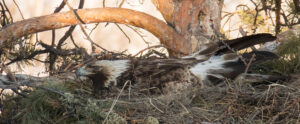Third International Scientific and Practical Conference “Eagles of the Palearctic: Study and Conservation”
Raptors Conservation. Suppl. 2. Proceedings of Conferences
Diet of a Golden Eagle on the Middle Lena, Yakutia, Russia
Gabyshev V.Yu., Isaev A.P. (Institute for Biological Problems of Cryolithozone of the Siberian Branch of the Russian Academy of Sciences, Yakutsk, Russia)
Bochkarev V.V. (The State Yakutia United Museum of History and Culture of the People of the North named after Em. Yaroslavsky, Yakutsk, Russia)
Shemyakin E.V., Lukin A.R., Vasilyeva V.K. (Institute for Biological Problems of Cryolithozone of the Siberian Branch of the Russian Academy of Sciences, Yakutsk, Russia)
Bochkarev V.V. (The State Yakutia United Museum of History and Culture of the People of the North named after Em. Yaroslavsky, Yakutsk, Russia)
Shemyakin E.V., Lukin A.R., Vasilyeva V.K. (Institute for Biological Problems of Cryolithozone of the Siberian Branch of the Russian Academy of Sciences, Yakutsk, Russia)
Contact:
Viacheslav Gabyshev gabvich@mail.ru
Arkady Isaev isaev_ark@rambler.ru
Vladimir Bochkarev vovabochkarev89@mail.ru
Evgeniy Shemyakin shemyakine@mail.ru
Anatoliy Lukin anatolukin@mail.ru
Vera Vasilyeva vasvekim@yandex.ru
Recommended citation: Gabyshev V.Yu., Isaev A.P., Bochkarev V.V., Shemyakin E.V., Lukin A.R., Vasilyeva V.K. Diet of a Golden Eagle on the Middle Lena, Yakutia, Russia. – Raptors Conservation. 2023. S2: 26–29. DOI: 10.19074/1814-8654-2023-2-26-29 URL: http://rrrcn.ru/en/archives/34831
Presented data on the Golden Eagle (Aquila chrysaetos) diet is based on the analysis of 291 pellets and 233 food remains found in or under nests and perches. Data was also obtained based on visual information. Small rodents were identified by teeth structure, birds – by femur and humerus sizes. If possible, species was determined by mammal hairs and bird feathers found in pellets or food remains. Information on the Golden Eagle diet was obtained between 2006 and 2023 in three administrative areas of Yakutia (Khangalassky and Namsky districts, administrative area of the city of Yakutsk) located in the basin of the middle reaches of Lena (Middle Lena). The study area has a wide and complexly terraced valley, 70% of which is covered by taiga with combination of coniferous (larch, spruce, pine) and small-leaved (willow, birch) forests, meadows, and agricultural land. The Middle Lena is characterized by an extremely continental climate and a short summer: average temperature in January is -43.2°, in June – +18,0°, frostfree period lasts 95 days.
Previously Golden Eagle nested throughout the taiga of Yakutia, and until the early 1960s was a common species in the Middle Lena (Vorobiev, 1963). Since the 1970s– 1980s a sharp decrease in its abundance was recorded, and since the 1990s it has become extremely rare (Solomonov, Larionov, 1976; Borisov, 1987; Isaev et al., 2020). According to our observations, since the beginning of the 2000s there was a gradual increase in the number of Golden Eagle and the emergence of breeding territories in areas where Golden Eagles were absent for a long-time during breeding period. Today, 33 Golden Eagle nests are known in the Middle Lena, breeding occurred in 11 of them. The Golden Eagle arrival is usually observed from the second decade of March to the first decade of April. Golden Eagle lays eggs in April, nestlings hatch in May and depart from nests in September– October.
Research by Yu.V. Labutin (1992) shows that in the 1970s–1980s, the main food source for Golden Eagle in Central Yakutia was Mountain Hare (89%); according to G.P. Larionov et al. (1991), in the 1980s– 1990s this species accounted for 37.7% of prey. It should be noted that in the beginning-middle of the 20th century, Mountain Hare was one of the most common species in Central Yakutia, and in years of its peak abundance – massive commercial species, as almost 850,000 hare skins were harvested then. A steady downward trend in the number of species has begun from the 1970s, the population size has decreased, mainly due to the anthropogenic factor (Solomonov, 1975). Since 2000s, hare hunting has ceased due to its low numbers in the region. Accounting that has been carried out in Central Yakutia in 2008–2018 showed that the number of species is very low – 0.2–0.3 individuals/10 km of the route (Sedalishchev, Odnokurtsev, 2022).
As shown by the recent data, 11 mammal and 29 bird species are found in the Golden Eagle diet in Central Yakutia, and Long-Tailed Ground Squirrel has become its main prey. The predominance of Ground Squirrels in the diet suggests that, due to an increase in hare abundance, Golden Eagle switched to species with higher population density. The diet of Golden Eagle changes depending on the season. The greatest prey variety is observed in spring; eagles feed on young Roe Deer, Ground Squirrels, less often – hare, sable, etc. There are also reports of Golden Eagles attacking exhausted adult Roe Deer in early spring. It is worth noting that, judging by the survey data, Golden Eagles were often observed near fallen horses. While horse hairs were found in only one of the examined pellets, it confirmed Golden Eagle feeding on horse meat. From the beginning of June, Golden Eagle switch to its main prey, the Long-Tailed Ground Squirrel, occasionally feeding on small mammals and passerine birds. Interestingly, insects are sometimes found in pellets collected in Golden Eagle nests.

